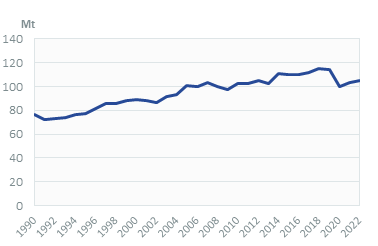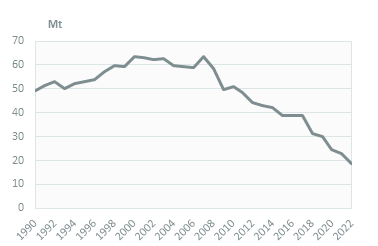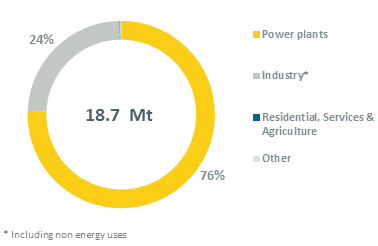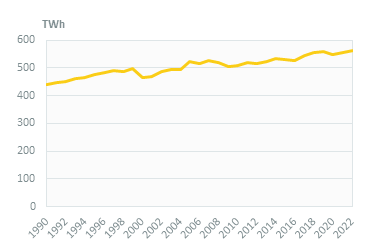-
-
 Energy and Climate Databases
Energy and Climate Databases- The most comprehensive and up-to-date annual energy database.
- Monitoring of technology providers in H2 supply chain.
- Monthly energy data on key energy markets.
- The most reliable and up-to-date power generation database.
- The essentials of LNG trade at your fingertips.
- Global monitoring of new and existing refineries.
- Analyse energy consumption and efficiency trends at world level. Benchmark countries.
- Have your database developed by a recognised expert of both energy and IT.
-
 Energy - Climate Forecasts
Energy - Climate Forecasts- Instant access to energy and emissions forecasts.
- Strategic, annual wholesale price projections backed by Enerdata's energy modelling expertise and our globally recognised POLES model.
- Wedges module showing a breakdown of the levers enabling to reduce emissions between two scenarios.
- Unique, independent projections of consumption by end-use.
- GHG Marginal Abatement Cost Curves.
- Benefit from proven models to draw your own energy scenarios and anticipate tomorrow’s challenges.
-
 Market Intelligence
Market Intelligence- 110 Energy and climate country reports
- A newsletter to receive the latest updates on evolving technologies and policies.
- Global energy news and analyses curated daily.
- Enerdata’s experts bring you the essentials about your market and competitors.
-
-
-
 Market Analysis
Market Analysis- Understanding key consumption trends and drivers across sectors.
- Granular and exclusive insight to address the most pressing business and strategic issues.
- Expertise in strategic and business intelligence, with fine-tuning to the market’s specificities.
-
 Energy - Climate Scenarios
Energy - Climate Scenarios- Providing the outlook of an energy commodity in mid to long term time horizons.
- Sector and driver specific energy demand forecasting.
- Assess the evolution of energy prices on the international and regional markets, as well as end-users prices.
- Enerdata guides you through pathways to reach climate targets.
- Supporting local authorities in their decarbonisation strategies.
-
 Climate Strategy and Policy Evaluation
Climate Strategy and Policy Evaluation- Cutting-edge quantitative tools and relevant indicators to monitor and evaluate evolutions on worldwide energy markets.
- Analysis of the most cost-effective options to reduce emissions.
- Quantified simulation and analysis of pledges for climate change negotiations.
- Breakdown of carbon markets and evaluation of the climate change impacts on the carbon price.
- Enerdata guides you on the most beneficial policy or investment options.
- Turning climate objectives into concrete action plans.
-
 Training
Training- Understand different policy targets and measures on energy efficiency.
- How to measure energy savings?
- Energy Forecasting is a 2 days training to learn to design and interpret energy forecasts.
- Energy statistics training allowing to create energy balance with supply, transformation and consumption and understanding the international energy statistics regulations.
- Initiation to EnerMED level 1is the training to approach on the most powerful energy demand forecasting model.
-
-
Resource Centre
Canada Key Figures
- Population:
- 40.0 million
- GDP growth rate:
- 1.07 %/year
- Energy independence:
- 100%
Data of the last year available: 2023
- Total consumption/GDP:*
- 81.0 (2005=100)
- CO2 Emissions:
- 13.5 tCO2/capita
- Rate of T&D power losses:
- 5.33%
* at purchasing power parity
View all macro and energy indicators in the Canada energy report
Canada Energy News
View all news, archive your new and create your own daily newsletters only on your topics/countries of interest with Key Energy Intelligence
Canada Energy Research
Benefit from up to 2 000 up-to-date data series for 186 countries in Global Energy & CO2 data
A data overview is available in the global energy statistics app
Canada Total Energy Consumption
At 7.4 toe, Canada's per capita energy consumption is among the highest in the world and almost triple the average EU level. Electricity consumption per capita is around 13.9 MWh.
Total energy consumption decreased slightly, by 1.2% in 2023 to 295 Mtoe, following a slight progression from 2010 to 2022 (1.3%/year on average at normal climate), except for a 6.7% drop in 2020.
Interactive Chart Canada Total Energy Consumption
Benefit from up to 2 000 up-to-date data series for 186 countries in Global Energy & CO2 data
View the detailed fondamentals of the market at country level (graphs, tables, analysis) in the Canada energy report
Canada Crude Oil Production
Oil production (crude, NGL, and non-conventional oil) increased by 73% since 2010 (of which +2.5% in 2022 and +1.4% in 2023), reaching 289 Mt in 2023. It has more than doubled since 2000. The increase in production follows the development of non-conventional oil, which accounted for about 60% of the country's oil production in 2023.
Interactive Chart Canada Crude Oil Production
Benefit from up to 2 000 up-to-date data series for 186 countries in Global Energy & CO2 data
Additionally, for more detailed information on refineries, you can request a sample of our America Refineries Dataset
Canada Oil Products Consumption
The consumption of oil products remained roughly stable (-0.6%) in 2023, at 103 Mt. It followed a 6% increase in 2022, after a 3% progression in 2021 and a 12% drop in 2020.
The transport sector is the biggest consumer of oil products (50% in 2023), followed by industry with 42% (including non-energy uses and the hydrocarbon industry).
Graph: OIL CONSUMPTION (Mt)

Graph: OIL CONSUMPTION BREAKDOWN BY SECTOR (2023, %)
Interactive Chart Canada Refined Oil Products Production
Benefit from up to 2 000 up-to-date data series for 186 countries in Global Energy & CO2 data
Additionally, for more detailed information on refineries, you can request a sample of our America Refineries Dataset
Canada Natural Gas Consumption
The consumption of natural gas decreased by almost 2% in 2023, reaching 145 bcm. It grew by around 4%/year between 2020 and 2022, after a 4.5% drop in 2020 following an increasing trend, with particularly significant growth between 2015 and 2018 (+11%/year).
The oil and gas sector, in particular the exploitation of oil sands, is the largest consumer of natural gas, with 43%. It is followed by buildings (23%) and industry and power plants (16% each).
Graph: NATURAL GAS CONSUMPTION (2023, bcm)
Interactive Chart Canada Natural Gas Domestic Consumption
Benefit from up to 2 000 up-to-date data series for 186 countries in Global Energy & CO2 data
Additionally, for more detailed information on the LNG trade, you can request a sample of our America LNG Trade Dataset
Canada Coal Consumption
Coal and lignite consumption has been decreasing regularly and rapidly since 2008 to 17.1 Mt in 2023 (around 8%/year).
The power sector represents 77% of consumption and the remaining 23% is dedicated to industrial purposes.
Graph: COAL CONSUMPTION (Mt)

Graph: COAL CONSUMPTION BREAKDOWN BY SECTOR (2023, %)

Interactive Chart Canada Coal and Lignite Domestic Consumption
Benefit from up to 2 000 up-to-date data series for 186 countries in Global Energy & CO2 data
View the detailed consumption trends at country level (graphs, tables, analysis) in the Canada energy report
Canada Power Consumption
Electricity consumption remained stable in 2023 (558 TWh). Except for a 2.4% drop in 2020, it grew between 2020 and 2022 at a rate close to its historical trend (1%/year between 2015 and 2019).
Industry is the largest electricity consumer (34%), closely followed by the residential (32%) and services sectors (27%).
Graph: ELECTRICITY CONSUMPTION (TWh)

Graph: ELECTRICITY CONSUMPTION BREAKDOWN BY SECTOR (2023, %)
Canada Renewable in % Electricity Production
In its Towards Canada's 2030 Agenda National Strategy (2021), the country pledged to generate 90% of its electricity from renewables and non-emitting sources by 2030.
Interactive Chart Canada Share of Renewables in Electricity Production (incl hydro)
Benefit from up to 2 000 up-to-date data series for 186 countries in Global Energy & CO2 data
Canada CO2 Fuel Combustion/CO2 Emissions
Canada updated its NDC in 2021 with a goal of reducing GHG emissions to 40 to 45% of 2005 levels by 2030. The country is also committed to achieving net-zero GHG emissions by 2050.